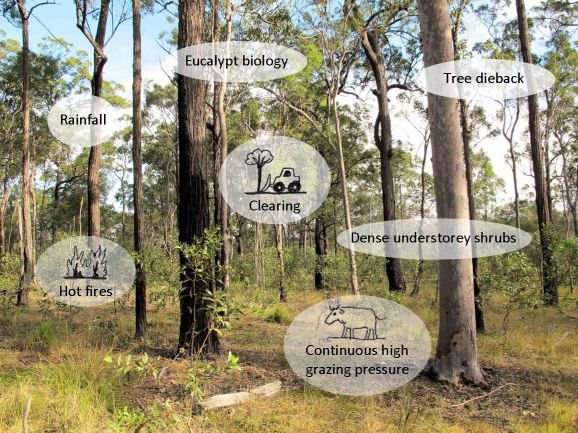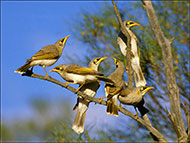Ecology


The biology of open-forest eucalypts
Open-forest eucalypts usually flower every year, but the flowering season varies within and between species and sites. The flowers are visited or pollinated by insects, birds, flying foxes and gliders.
Many tropical and subtropical eucalypt species drop their seeds and fruit only weeks or months after flowering and fire is generally not needed to trigger the release of seed in tropical eucalypt species. The seed of most open-forest eucalypts does not remain viable in the soil for more than 12 months. Seeds are small and are mainly dispersed by wind and water.
The germination and establishment of seedlings tends to be ongoing when seed is available. This is in contrast to some types of forest where disturbance, the creation of large canopy gaps, or burning to expose mineral earth is needed for seedling establishment. Growth in seedling height may be more rapid when open-forest eucalypt seedlings develop on an ash-bed, but this is not always the case. These enhanced growth rates may also diminish once the canopy is re-established.
Most open-forest eucalypt species develop a lignotuber in the early months of growth. This enables them to survive all but the most severe fires, and to regrow rapidly if their crowns are damaged. As a result, a pool of lignotuberous seedlings and saplings tends to accumulate in the understorey of eucalypt open-forests.
These plants are capable of withstanding high temperatures, drought, browsing and fires, and may persist for many years. When mature trees are lost from the canopy, these tend to be rapidly replaced by saplings from the understorey. Open-forest eucalypts tend to be taller and straighter than their woodland counterparts. Their trunks are generally taller than their crowns, while woodland species tend to have more crown than trunk.
Dense understorey shrubs (including lantana)
Eucalypts are relatively intolerant of shade, so high densities of understorey shrubs (for example lantana, Lantana camara) and small trees such as wattles (Acacia species) may prevent open-forest eucalypt seedlings establishing and growing.
Eucalypts have long lifespans (more than 100 years), so a high rate of seedling recruitment (for example every 1 to10 years) is not necessary to ensure old trees are replaced when they die. Therefore the control of dense shrubs to allow tree recruitment may only be needed if recruitment is obviously being suppressed over an extended period of time.
Fire
Fire is part of the ecology of eucalypt open-forests, and many plants and animals have adaptations that enable them to survive fire, or may even benefit from certain fire regimes. Fire has a limited effect on the recruitment of open-forest eucalypts, as long as plants have already developed lignotubers. There is no evidence that there is more rapid loss of well-established lignotuberous eucalypt plants from the regeneration pool under an annual-burning regime than in an unburnt forest.
However, hot fires may slow the growth of trees, particularly from the pool of small saplings into taller saplings. Fires of low to moderate intensity (such as where there is little or no scorch of tree crowns) will have little effect on the growth of open-forest eucalypt species. Hot fires are also more likely than fires of low to moderate intensity to kill trees, scorch tree crowns, reduce diameter growth, damage stems, and help damaging insects and fungi enter trunks and stems.
Grazing pressure
Even relatively intense grazing by wallabies and cattle does not appear to prevent some open-forest eucalypt species establishing and growing. Young seedlings can die if shoots are removed before they have developed a large enough lignotuber.
In a glasshouse study, seedlings of Corymbia citriodora subsp. variegata developed a lignotuber large enough to survive defoliation after only about 4 months growth, while Eucalyptus acmenoides and Eucalyptus siderophloia needed about 6 months to develop lignotubers of a similar size. It should be noted that rates of lignotuber development may differ in a field situation.
Clearing
Open-forest eucalypts are likely to regrow readily after clearing if healthy trees are nearby to provide seed, rainfall is adequate, soil conditions are suitable and dense shrubs do not suppress the seedlings. Regrowth may come from new seedlings but is more likely to develop from root suckers, the resprouting of cut stumps, and from a ‘bank’ of seedlings and saplings that were present before the site was cleared. While this can create problems for maintaining pastures it can be useful for farming carbon by reforestation.
Establishing fewer, ultimately larger, trees (rather than dense thickets of small trees) is best for maximising carbon (see farming carbon for more details).
Tree clearing also includes thinning, where some trees are left for timber production, shade and shelter. Thinning can increase the rate and amount of carbon accumulated in the remaining trees, but it is often expensive. It may be more cost-effective to maintain forested areas as distinct paddocks, or as tree strips, rather than maintaining low tree density in pastures by resisting the trees’ capacity to multiply. Dead timber should be kept on site as debris as this will contribute to carbon storage and wildlife habitat.

Tree dieback
Mature eucalypts declining and dying prematurely has been recorded in many parts of Queensland. Dieback is often characterised by cycles of defoliation followed by epicormic growth, reduced flowering, and increasing numbers of bare dead branches in the tree canopy.
Many factors appear to contribute to tree dieback including drought, tree clearing, being eaten by insects, livestock grazing, salinity and waterlogging. The effects can vary with location. However, this type of dieback is more severe in areas of intensive land management such as properties with large areas of fertilised crops and pastures.
Loss of native animals and plants from rural landscapes may also contribute to tree dieback. Some natural insect-controllers (such as echidnas, sugar gliders and wasps) may be unable to regulate insects in cleared landscapes, as the other habitat features that they require (such as fallen timber and a diversity of understorey shrubs) are scarce or absent.
Increases in the populations of large, territorial miner birds (noisy miners Manorina melanocephala, yellow-throated miners M. flavigula and bell miners M. melanophrys) often displace smaller insect-eating birds, and this may cause insect outbreaks and tree dieback, including the syndrome of Bell Miner Associated Dieback.
The factors which most influence the abundance of miners appear to vary across ecosystems. While increased abundances of bell miners have been associated with dense understorey vegetation, the abundance of the other miner species may increase with the amount of clearing, or with increased grazing pressure and reduced understorey density.
Rainfall
As eucalypt open-forests occur in areas of moderate rainfall they may be less susceptible to droughts than vegetation occurring in the drier parts of Queensland. Variation in rainfall is still likely to influence tree recruitment and growth, and fire regimes, in this vegetation type.


